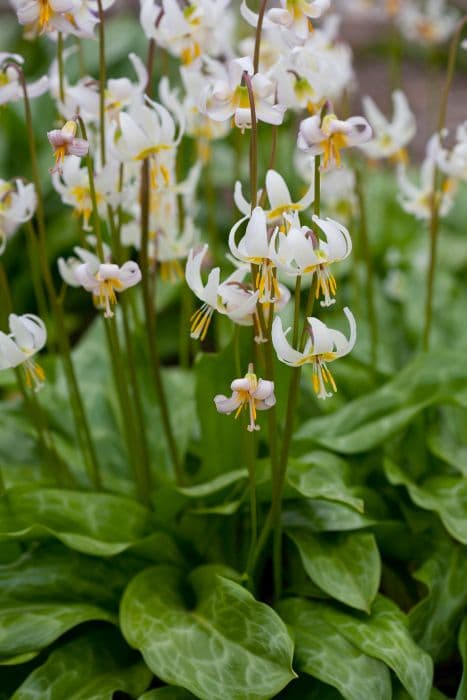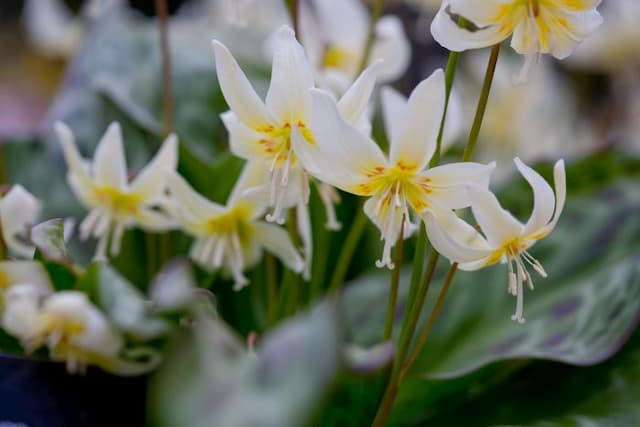Orienpet Lily Lilium 'Corsage' (Ib/b-c)

ABOUT
The Lilium 'Corsage' is a captivating plant known commonly as a lily. Displaying an elegant form, this variety is renowned for its striking flowers. The blossoms are typically large, trumpet-shaped, and exhibit a delightful array of colors that may include shades of pink, red, white, yellow, or orange, often with enchanting speckles or contrasting color patterns on the petals. Each exquisite flower comprises six broad petals that curl outward, creating an impressive display that resembles a luxurious corsage, as its name suggests. The lily's foliage adds to its graceful appearance, with dark green, glossy leaves arranged in whorls or spirals along the stem, providing a lush backdrop for the opulent blooms. The leaves themselves may be narrow and elongated, accentuating the dignified stature of the plant. The overall look of the Lilium 'Corsage' lily is one of sophistication and beauty, making it a prized selection for ornamental gardens and floral arrangements.
About this plant
 Names
NamesFamily
Liliaceae
Synonyms
Corsage Lily
Common names
Lilium 'Corsage' (Ib/b-c).
 Toxicity
ToxicityTo humans
The common name for Lilium 'Corsage' is Lily. Lilies are generally not considered highly toxic to humans, but they can trigger minor symptoms if ingested. These symptoms may include nausea, vomiting, or diarrhea. However, they can be more harmful if a person has a particular sensitivity to them. It's advised to keep all parts of the plant out of reach of small children who might inadvertently ingest them.
To pets
The common name for Lilium 'Corsage' is Lily. Lilies are extremely toxic to cats and can lead to acute kidney failure. Even small ingestions, such as a few petals or leaves, pollen, or water from the vase, can be potentially fatal. Symptoms of lily poisoning in pets, particularly cats, include vomiting, lethargy, loss of appetite, and subsequently, possible kidney failure, which can occur within days and may be fatal without prompt veterinary treatment. If you suspect your pet has ingested any part of a lily, seek veterinary assistance immediately. Dogs are not as sensitive to lilies as cats, but stomach upset is still a possible consequence of ingestion.
 Characteristics
CharacteristicsLife cycle
Perennials
Foliage type
Deciduous
Color of leaves
Green
Flower color
Varies
Height
3 feet (0.91 meters)
Spread
1 foot (0.30 meters)
Plant type
Bulb
Hardiness zones
4
Native area
Asia
Benefits
 General Benefits
General Benefits- Ornamental appeal: The Lilium 'Corsage', commonly known as Oriental Lily, boasts large, fragrant flowers that enhance the visual aesthetics of gardens and landscapes.
- Cut flower usage: Its sturdy stems and long-lasting blooms make it an excellent choice for cut flower arrangements, adding elegance to bouquets and vase displays.
- Pollinator attraction: The vibrant flowers attract pollinators such as bees, butterflies, and birds, supporting local ecosystems.
- Versatility in landscaping: Oriental Lily can be planted in borders, flower beds, or containers, offering versatility for different garden designs and spaces.
- Seasonal interest: It blooms in the summer, providing color and interest to the garden during this season.
- Perennial growth: As a perennial plant, it returns each year, reducing the need for annual replanting and maintenance.
- Hybrid vigor: Being a hybrid, the Oriental Lily often demonstrates improved growth characteristics and disease resistance compared to its parent species.
 Medical Properties
Medical PropertiesThis plant is not used for medical purposes.
 Air-purifying Qualities
Air-purifying QualitiesThis plant is not specifically known for air purifying qualities.
 Other Uses
Other Uses- Craft Projects: The petals of lilies can be used in craft projects, such as creating natural dyes for fabrics or handmade papers.
- Garden Pest Deterrent: Some gardeners use the strong scent of lilies to deter animals and other pests from nibbling on more vulnerable plants in the garden.
- Floral Arrangements: Lily flowers are a popular choice for use in bridal bouquets and table centerpieces due to their large, showy blossoms.
- Culinary Garnishes: While not widely known, certain parts of lilies are edible and can be used to add a floral garnish to dishes, after ensuring they are free from pesticides and safe to eat.
- Photography Subject: The striking appearance of lilies makes them a favorite subject for photographers, especially those specializing in botanical and nature photography.
- Fragrance Production: Lily-scented perfumes and scented oils can be crafted using the natural fragrance of the flowers for a delicate and appealing aroma.
- Religious Ceremonies: Lilies are often used in religious ceremonies, representing purity and virtue in various cultural traditions around the world.
- Artistic Inspiration: The form and beauty of the lily have inspired many artists to include the blooms in paintings, drawings, and other forms of artwork.
- Candle Making: The petals or essence of lilies can be incorporated into candles to create a calming and aesthetically pleasing lily-scented candle.
- Wedding Decor: Beyond bouquets, lilies can be used to decorate wedding venues, from lining the aisle to adorning the altar or reception area.
Interesting Facts
 Feng Shui
Feng ShuiThe plant referred to as Lily is not used in Feng Shui practice.
 Zodiac Sign Compitability
Zodiac Sign CompitabilityThe Lily is not used in astrology practice.
 Plant Symbolism
Plant Symbolism- Peace & Tranquility: Lilies are often associated with peace and tranquility, which is why they are commonly used in spaces designed to create a calm and peaceful atmosphere.
- Purity & Virtue: The white lily, in particular, is a symbol of purity and virtue, making it a popular choice for religious ceremonies and weddings.
- Renewal & Rebirth: Lilies bloom in the spring, symbolizing renewal and rebirth, which ties into the themes of Easter and new beginnings.
- Motherhood & Fertility: In various cultures, lilies are associated with motherhood and fertility, resonating with the plant's natural reproductive processes.
- Transitions & Endings: Lilies are also symbolic of transitions and endings, often used at funerals to represent the soul's departure and the cycle of life.
- Royalty & Pride: Their majestic appearance gives lilies an association with royalty and pride, showcasing their standing as a luxurious and prestigious flower.
 Water
WaterOriental lilies, like 'Corsage', prefer consistently moist soil without being waterlogged. Water deeply so that the water reaches the roots, about once a week, providing about 1 to 1.5 gallons per square yard of soil during the growing season. Increase watering frequency during hot, dry periods to maintain soil moisture but always check the soil moisture before watering to avoid overwatering. In the fall, as the plant goes dormant, reduce watering to encourage the plant to rest.
 Light
LightOriental lilies, such as the 'Corsage', thrive in full sun to partial shade. The ideal location is where they can receive six to eight hours of direct sunlight per day, avoiding the intense midday sun which can scorch the leaves. A spot that offers morning sunlight with some afternoon shade is often perfect for these lilies to grow and bloom prolifically.
 Temperature
TemperatureOriental lilies, including 'Corsage', perform best in temperatures ranging from 60 to 70 degrees Fahrenheit during the day and no lower than 55 degrees at night. They can survive temperature dips down to about 40 degrees, but the ideal growing conditions are the moderate temperatures of typical spring and early summer weather. These lilies are not suited for extreme heat or freezing conditions.
 Pruning
Pruning'Corsage' Oriental lilies generally require minimal pruning, but spent flowers can be removed to keep plants looking tidy and prevent seed formation. After flowering, trim off old flowers but leave the stems and leaves to die back naturally, as they provide energy for the bulb for next year's growth. Pruning back to the ground should be done after foliage has yellowed and died back completely in the fall.
 Cleaning
CleaningAs needed
 Soil
SoilThe best soil mix for Lilium 'Corsage', commonly known as Orienpet Lily, should be well-draining, rich in organic matter with an added mix of sand and leaf mold or compost to improve texture. The ideal soil pH for Orienpet Lilies should be slightly acidic to neutral, ranging from 6.0 to 7.0.
 Repotting
RepottingOrienpet Lilies typically do not need frequent repotting and can thrive if left undisturbed for several years. Generally, repotting every 3 to 4 years is adequate, preferably in the fall after the foliage has died back.
 Humidity & Misting
Humidity & MistingOrienpet Lilies prefer moderate humidity levels. They thrive best when humidity ranges between 40-60%, which is often the typical range found in many home environments.
 Suitable locations
Suitable locationsIndoor
Ensure bright indirect light and cool temperatures for Orienpet Lily.
Outdoor
Plant in well-draining soil, full sun to partial shade for Orienpet Lily.
Hardiness zone
4-9 USDA
 Life cycle
Life cycleThe life cycle of the Lily 'Corsage' (Ib/b-c) begins with seed germination, which occurs in a moist environment with proper temperature conditions, leading to the emergence of the primary root and shoot. After germination, the plant enters a vegetative phase characterized by the growth of leaves, stems, and roots as it establishes itself. As the lily matures, it transitions into the flowering stage, wherein bud formation occurs followed by the blossoming of the distinctive large, fragrant flowers. Post-pollination, if successful, leads to seed production within the ovary, encapsulated in a fruiting structure. Following seed dispersal, the plant may enter a period of dormancy, especially in colder climates, where it conserves energy by dying back to the bulb before resurging in the next growing season. Throughout its life, the lily 'Corsage' relies on appropriate care, including suitable soil, water, and light conditions, to advance through these stages and complete its life cycle.
 Propogation
PropogationPropogation time
Spring-early summer
The most popular method of propagation for the Lilium 'Corsage', commonly known as the Oriental-Trumpet hybrid lily, is by scaling. This is usually done in late summer after the lily has finished blooming. To propagate by scaling, carefully remove a few scales from the basal plate of the bulb without damaging the bulb itself. These scales can then be placed in a mixture of peat moss and perlite, maintaining slight moisture and wrapping them in a plastic bag to create a mini-greenhouse effect. Place the bag in a warm, shaded area, at about 68-70 degrees Fahrenheit (20-21 degrees Celsius), and in about six to eight weeks, tiny bulbils will form at the base of the scales. These can then be planted in individual pots or directly in the garden.








